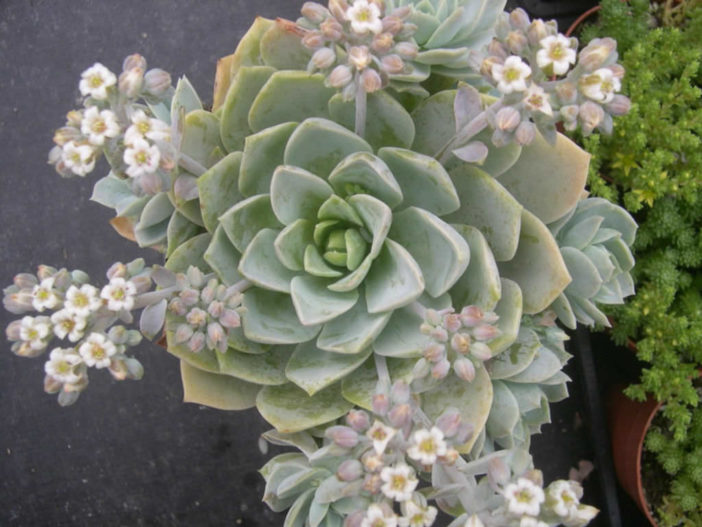Scientific Name
Sedum suaveolens Kimnach
Common Name(s)
Sweet Smelling Sedum
Synonym(s)
Graptopetalum suaveolens
Scientific Classification
Family: Crassulaceae
Subfamily: Sempervivoideae
Tribe: Sedeae
Genus: Sedum
Description
Sedum suaveolens is a cute clump-forming succulent with short-stemmed rosettes of thick, fleshy, blue-green leaves heavily covered with a fine waxy bloom and often tinged pink. The stems are up to 1.2 inches (3 cm) long and up to 0.6 inches (1.5 cm) in diameter. Rosettes grow up to 8 inches (20 cm) in diameter, producing offsets on short stolons to form a clump up to 20 inches (50 cm) in diameter. Leaves are ovate with a narrower end at the base, ending in a sharp point, up to 2.4 inches (6 cm) long and 1.6 inches (4 cm) wide. They are flattened at the upper surface, keeled below, and slightly curving towards the tip.
Like the stolons, short inflorescences, barely reaching beyond the edge of the leaves, in summer appear from within the rosette, bearing urn-shaped, 5-merous, sweet-scented flowers. The petals are white with greenish-yellow midstripe near the tip.
Origin
Sedum suaveolens is native to Mexico (Durango). It grows in shaded cliff faces at elevations of about 3,770 feet (1,150 m).
Etymology
The specific epithet "suaveolens (swah-vee-OH-lens)" means "sweet-smelling, fragrant" and refers to flowers that have a sweet, pleasant smell.

Hardiness
USDA hardiness zones 9b to 11b: from 25 °F (−3.9 °C) to 50 °F (+10 °C).
How to Grow and Care
When growing Sedums, keep in mind that these plants need very little attention or care. They will thrive in conditions many other plants thrive in but do just as well in less hospitable areas. They are ideal for that part of your yard that gets too much sun or too little water to grow anything else. A common name for Sedum is Stonecrop because many gardeners joke that only stones need less care and live longer.
Sedum is easily planted. For shorter varieties, simply laying the plant on the ground where you want it to grow is usually enough to get the plant started there. They will send out roots from wherever the stem touches the ground and root itself. If you want to ensure that the plant will start there, you can add a very thin soil covering.
You can break off one of the stems for taller varieties and push it into the ground where you want to grow it. The stem will root very easily, and a new plant will be established in a season or two.
Learn more at How to Grow and Care for Sedum.
Hybrids
Links
- Back to genus Sedum
- Succupedia: Browse succulents by Scientific Name, Common Name, Genus, Family, USDA Hardiness Zone, Origin, or cacti by Genus
Photo Gallery
Click on a photo to see a larger version.



